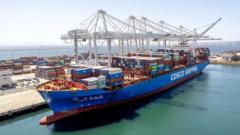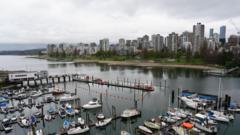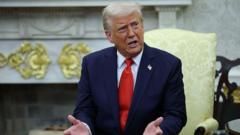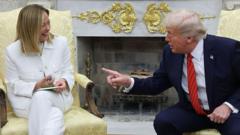Despite the buzz in popular shopping districts, consumer spending in China struggles as tariffs bite.
China's Consumption Strategy Faces Challenges Amid Trade War

China's Consumption Strategy Faces Challenges Amid Trade War
As U.S.-China trade tensions escalate, will domestic spending be enough to counteract economic downturns?
As the U.S. and China escalate their trade war, a vibrant scene of shoppers fills Beijing’s Taikoo Li, portraying a façade of normalcy amidst deepening economic strain. With U.S. tariffs on Chinese goods soaring above 125%, China's leadership remains resolute in its goal to pivot reliance from exports to domestic consumption as a means of economic salvation.
The Chinese government’s response to the tariffs includes imposing its own steep tariffs of 84% on U.S. imports, while simultaneously calling for a major shift towards fostering local consumption. “In light of the high tariffs that continue to threaten our trade relations with the United States,” stated a recent commentary in People’s Daily, “we will ensure that consumption becomes the key driver and stabilizing force for economic growth.”
However, the path to heightened consumption is fraught with obstacles. Even before the onset of tariffs, consumer spending faced challenges, characterized by a slow recovery from the COVID-19 pandemic. Many factories have closed, youth unemployment rates stand high, and declining home prices have left many middle-class households financially cautious.
While shoppers flock to the streets, their behavior reveals a different story; many are hesitant, seeking discounts or simply window shopping rather than making purchases. For instance, Qu Nan, a 38-year-old construction entrepreneur visiting Taikoo Li, was spotted at Starbucks not indulging in a drink but rather catching up with a friend. His situation reflects a broader hesitance among consumers, revealing that effortless bustling marketplaces might not tell the whole narrative of economic confidence in China. As government strategies aim to portray an image of resilience, the reality of consumer reluctance highlights the complexities of navigating economic recovery against a backdrop of international trade conflict.
The Chinese government’s response to the tariffs includes imposing its own steep tariffs of 84% on U.S. imports, while simultaneously calling for a major shift towards fostering local consumption. “In light of the high tariffs that continue to threaten our trade relations with the United States,” stated a recent commentary in People’s Daily, “we will ensure that consumption becomes the key driver and stabilizing force for economic growth.”
However, the path to heightened consumption is fraught with obstacles. Even before the onset of tariffs, consumer spending faced challenges, characterized by a slow recovery from the COVID-19 pandemic. Many factories have closed, youth unemployment rates stand high, and declining home prices have left many middle-class households financially cautious.
While shoppers flock to the streets, their behavior reveals a different story; many are hesitant, seeking discounts or simply window shopping rather than making purchases. For instance, Qu Nan, a 38-year-old construction entrepreneur visiting Taikoo Li, was spotted at Starbucks not indulging in a drink but rather catching up with a friend. His situation reflects a broader hesitance among consumers, revealing that effortless bustling marketplaces might not tell the whole narrative of economic confidence in China. As government strategies aim to portray an image of resilience, the reality of consumer reluctance highlights the complexities of navigating economic recovery against a backdrop of international trade conflict.




















